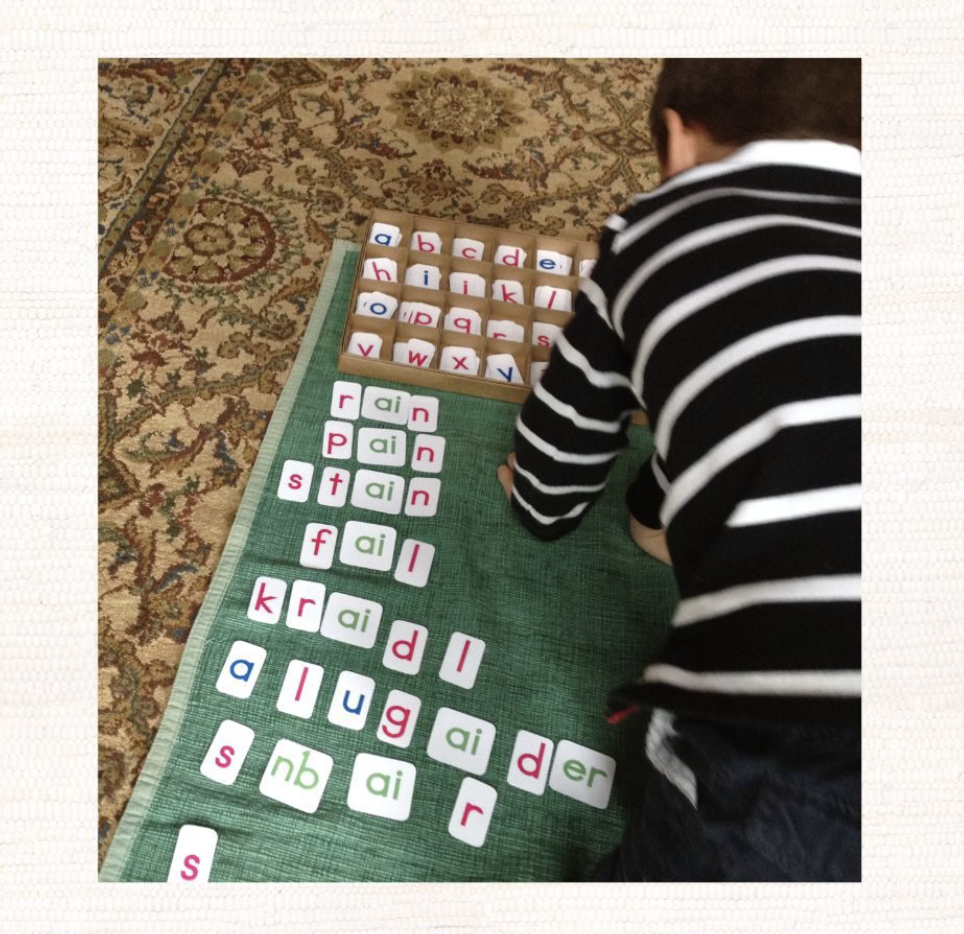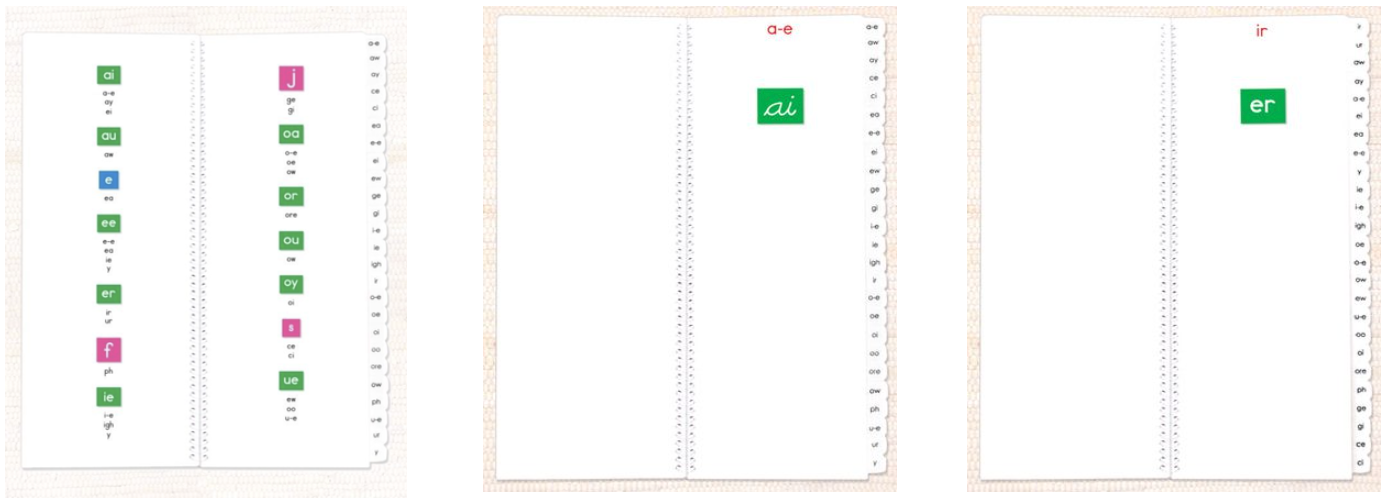Stress-Free Phonograms
Yes, children as young as 2.5 or 3-years-old can joyfully and effortlessly learn phonograms (two letters put together to make a single sound like ch, sh, or ee). We’re not talking about academic preschool here! We’re following the natural interests of the child. Let me show you what I mean.
First, if you prefer to watch videos, we’ve made a whole host of free video lesson plans with details on how to play all of the phonogram games we describe below. We’ll sum up the key ideas and fun activities here.
Step 1: Play Sound Games
“I spy with my little eye something on the rug that starts with “m” and ends with “th.” This is how we play the sound game (level 2) where we isolate the beginning and ending sounds in words.
To play this game, you can either (1) prepare a small collection of objects or images or (2) guide the children to gather their favorite items from the room. They will naturally bring things that include phonograms (book, for example, has the oo phonogram).
The key here is not to get stuck on beginning sounds (level 1). Be sure that you are helping children hear ending and middle sounds too. Read our blog post on the I Spy Sound Game in Four Steps for details on this essential activity.
Step 2: Teach the Sounds of the Letters
Trace a letter, say its sound, think of a few words that include that sound (anywhere in the word), and give the child a turn. That’s it! The key is to do this with vowels, consonants, AND phonograms. There is no need to hold phonograms back for older ages. In fact, holding them back hinders literacy development. Don’t get caught in that trap! Children anywhere from 2.5 to 4 years of age love to trace and say the letter sounds.
When you trace the letter, do it like it is the BEST thing you’ve ever done in your life! Keep asking for a turn. You want the children to trace these letters again and again and again as they say the letter sound. This helps them develop the part of their brain known as the letterbox (or visual word form area).
Tracing and saying the sound is the first step of the 3-period lesson. The next step is to play little games where you ask them to move the letters around, pick-up certain sounds, etc. This is super fun and where most of the learning takes place. Finally, when you’re 99% sure the child will be able to give you the right answer, point to a letter/phonogram and ask them to tell you what sound it makes. This is the hardest part so don’t go here too soon.
Step 3: Make ideas visible with the Movable Alphabets
Because you have traced those sandpaper letters and played sound games, your children are now ready to start building words with alphabet letter tiles! We call these movable alphabets and we begin with both the single and double letter alphabets. Why? Because together these create all the key sounds we need to phonetically spell any word in English.
Don’t worry about accurate spelling yet! Phonetically spelling words is a normal developmental step on the path to literacy. The more children write and read, the more curious they will become about which words are spelled which way. When they start asking about how something is really spelled, explain that in English, everybody got together and agreed on how to spell everything and sometimes it doesn't make sense. This opens them up to the fascinating world of the history of language (etymology).
When you get here, have fun trying to pronounce words like they used to be pronounced way back when English actually was a phonetic language. For example, try sounding out the word knight just like it’s spelled; this is how Kings and Earls used to say it back before Shakespeare’s time. The children will just giggle like crazy over this, all while effortlessly learning how to spell.
Step 4: Read Phonogram 3-Part Cards
After lots of writing practice, the children will naturally start sounding out words. When this happens, we can introduce 3-part cards that help them read independently.
Use these by laying out the photo-only cards. Then, invite the child to read the word labels and match them to the correct photo. When they’re done, they use the control card (photo and word on one card) to check their own work.
By offering the children lots of opportunities to read independently at the word level right from the very beginning, we help them build their internal dictionary of words they know. This gives them the knowledge and confidence they need to later dive into books of any length.
Step 5: Read Phonogram Lists
After phonogram 3-part cards, we can increase the challenge with phonogram lists. These isolate the phonogram of interest in red, but only in the top word. Do you see how we ease them away from the supports? By incrementally increasing the challenging, we don’t overwhelm them. Instead, they feel confident that they can handle the task before them.
Use these lists for reading activities but also for movable alphabet games. A child working alone can read a list and try to write as many words from memory as they can. Two children working together can play “dictation” where one child reads a word and the other child tries to spell it accurately. Then, they correct each others work: the peer-teaching and learning model in action!
Step 6: Alphabet Explorations
There are so many ways we can use the solid color movable alphabets to help children gain experience with phonograms. We can make lists of words that feature a particular phonogram. We can try to write fun sentences that include many words with the same phonogram. We can try to remember how to spell words from the Phonogram Spelling Folders (see below). We can write the two unique words in compound words in different colors. The possibilities are limitless.
If you want to go deep into all the ways to use the alphabets, check out our Language Album/Manual for teachers.
Step 7: Read Phonogram Spelling Folders
English spelling is a tangled web of history mixed with phonics. But there is an orderly way to introduce some of the common spelling variations so that children don’t feel overwhelmed by our tricky language.
The Phonogram Spelling Folders group common ways to spell a key sound together into cards and booklets. The children can read the booklets, match them to their cards, and even try mixing up and sorting out all the cards.
This approach draws attention to the parts of English spelling that make sense and follow some rules. Then, we can use these rules to figure out the words that don’t make any sense at all (although, for example).
Step 8: Look-up Sounds in the Phonogram Dictionary
Are your children coming up to you all the time asking you how to sound out new words? Then this is your solution! The next time they come across a word with a spelling variation they do not recognize, show them how to look for that variation on the tab, open to the corresponding page, and reveal the corresponding key sound. Voila! The answer is right there on the page.
This is a great support for independent reading.
Teaching & Learning Resources
Maitri Learning makes many materials that ease the child towards learning the complexities of English. If you want to go deeper with any of these activities, take a look at our Language Teacher Education Manual.
Let us know what you think by adding your thoughts in the comments below. Your experience will really help the rest of us!
















1 comment
This is both practical and reassuring! To boost literacy confidence, this post demystifies phonograms with stress-free steps, engaging visuals, and gentle repetition.
Sudha Acadamey
Leave a comment
This site is protected by hCaptcha and the hCaptcha Privacy Policy and Terms of Service apply.